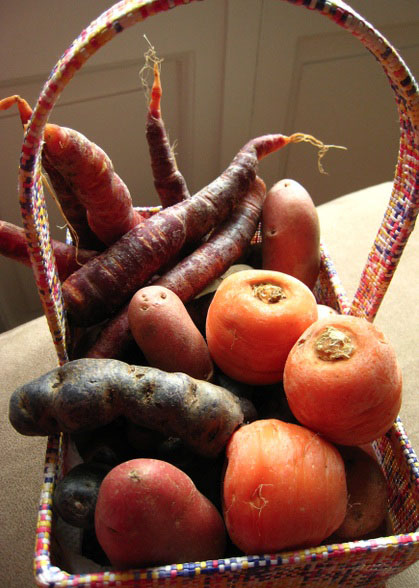 Once upon a time carrots were purple. Really they were! In Roman times, almost all carrots were purple or white. It was a mutant variety that had the orange color and sweeter taste. It took some industrious Dutch farmers several generations of breeding to select out the orange carrot that we have come to expect today.
Once upon a time carrots were purple. Really they were! In Roman times, almost all carrots were purple or white. It was a mutant variety that had the orange color and sweeter taste. It took some industrious Dutch farmers several generations of breeding to select out the orange carrot that we have come to expect today.
Most modern plants and livestock varieties share a similar history of selective breeding. While we only see two or three types of potatoes in a typical American grocery store, in the South American Andes there are some 5,000 potato varieties grown.
“Heirloom” or “heritage” plants and livestock breeds are important to maintaining food resilience. In the world of livestock, heritage animals were bred over time to produce more milk, gain weight quickly, and withstand the conditions of typical industrial production such as more cramped quarters and confinement. The heritage breeds on the other hand are often more capable of withstanding diseases and environmental changes, qualities that may be important in the future.
The American Livestock Breeds Conservancy is one of the non-profits focused on conserving the genetic heritage of over 180 breeds of livestock and poultry.
The Seed Savers Exchange is a non-profit that saves and distributes heirloom plant varieties. They believe, “A vibrant, diverse plant world is necessary for our survival, but that world is increasingly threatened by climate change, habitat loss, and over-exploitation.” The Millennium Seed Bank Partnership estimates that some 60,000 to 100,000 plant varieties are currently under threat of extinction.
In an effort to shift the tide and preserve the genetic diversity of plants in cultivation, the Seed Savers have a library of resources and an online store and catalog where you can purchase heirloom seeds for your garden. Try out some white cucumbers or delicious heirloom tomato varieties to do your part in propagating rare seeds and sowing sustainability.
